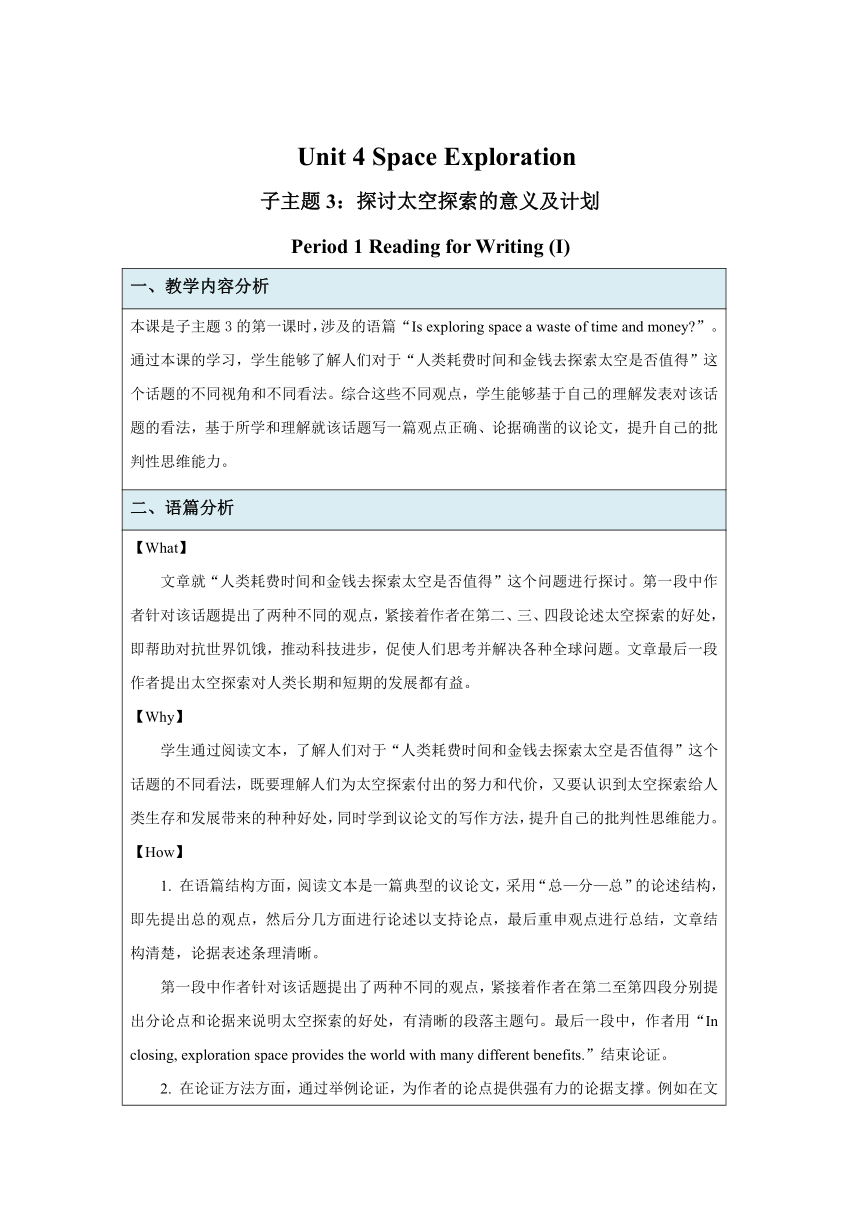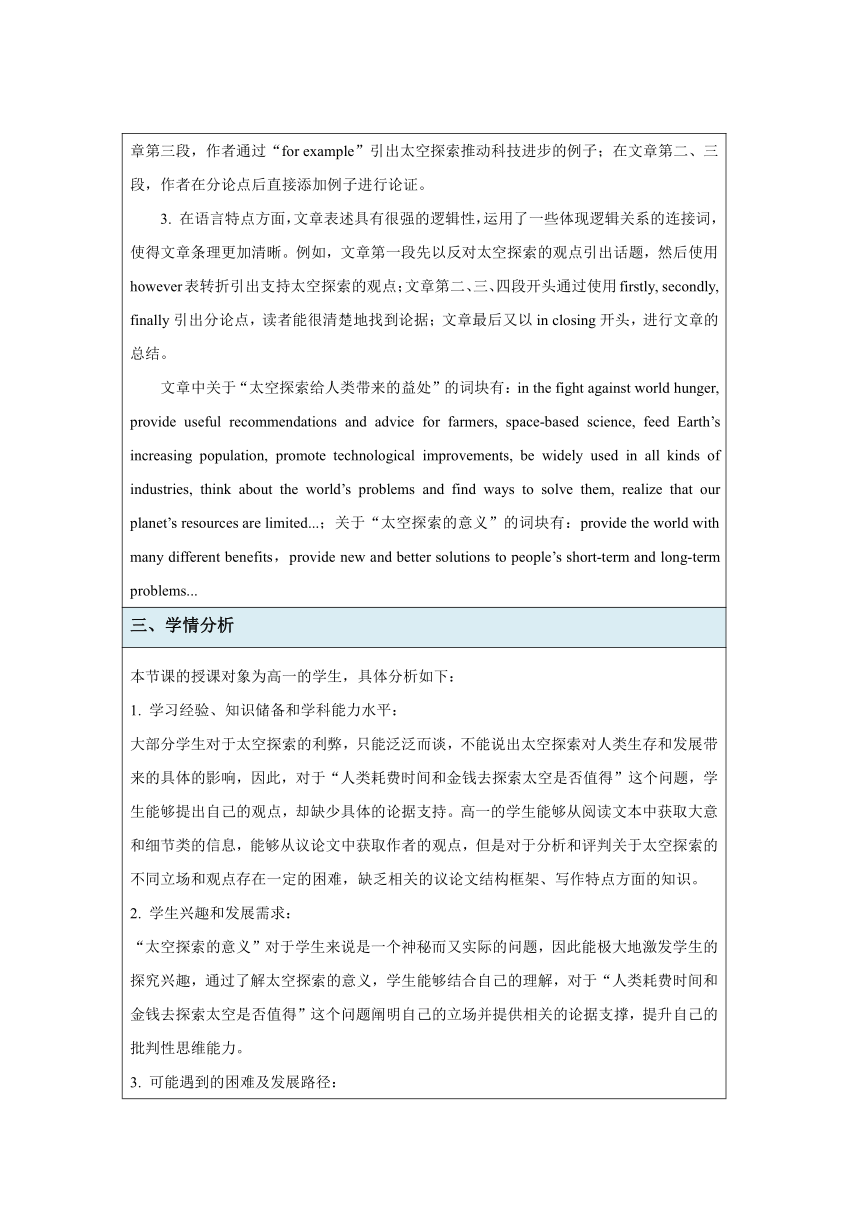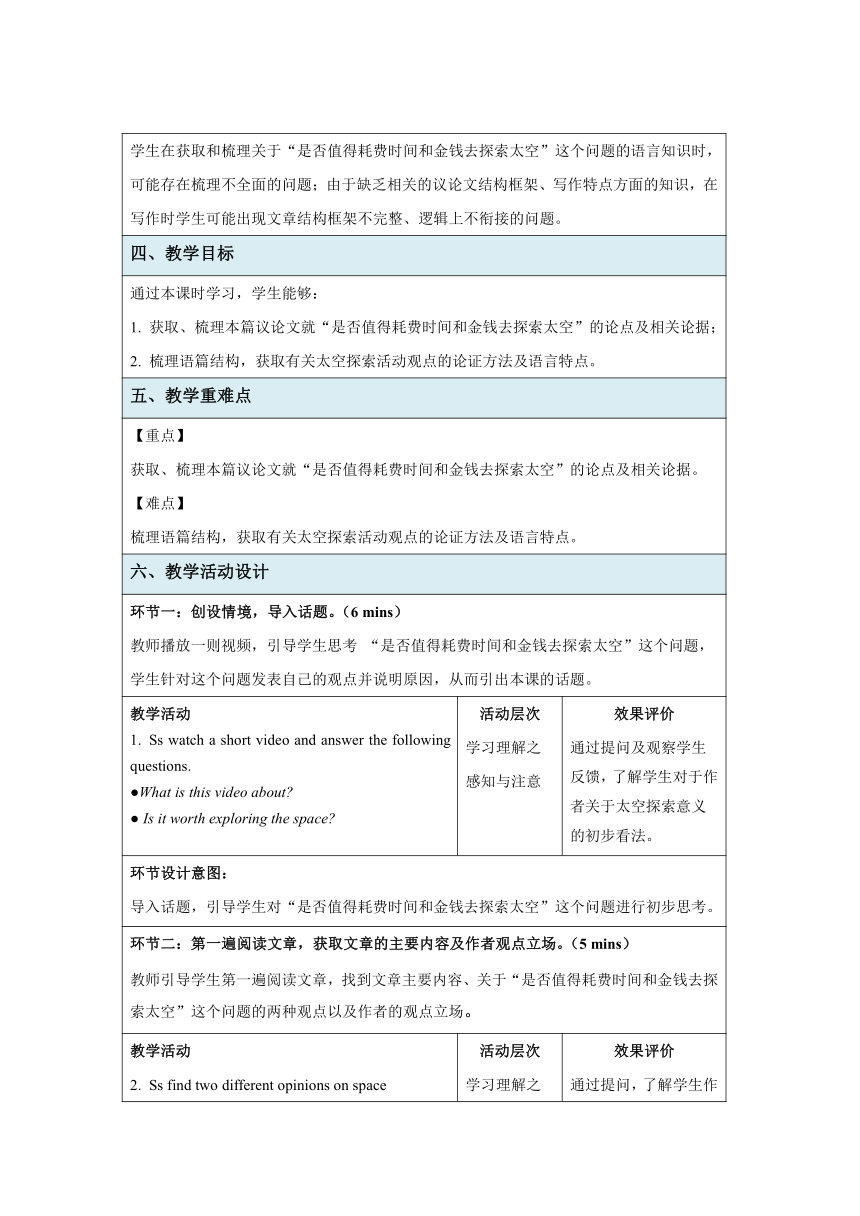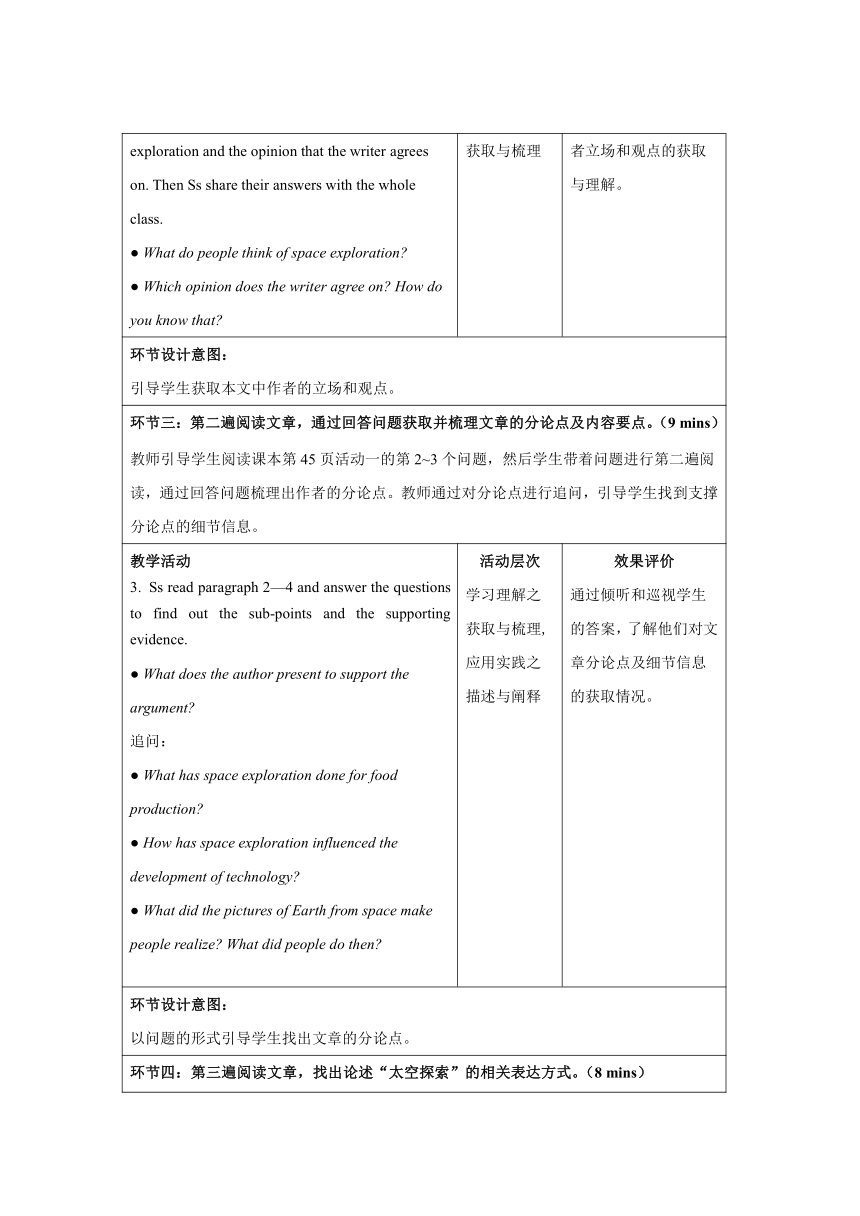人教版(2019)必修第三册Unit 4 Space Exploration Reading for Writing (I) 教案(表格式)
文档属性
| 名称 | 人教版(2019)必修第三册Unit 4 Space Exploration Reading for Writing (I) 教案(表格式) |

|
|
| 格式 | docx | ||
| 文件大小 | 35.8KB | ||
| 资源类型 | 教案 | ||
| 版本资源 | 人教版(2019) | ||
| 科目 | 英语 | ||
| 更新时间 | 2024-05-04 11:48:42 | ||
图片预览




文档简介
Unit 4 Space Exploration
子主题3:探讨太空探索的意义及计划
Period 1 Reading for Writing (I)
一、教学内容分析
本课是子主题3的第一课时,涉及的语篇“Is exploring space a waste of time and money ”。通过本课的学习,学生能够了解人们对于“人类耗费时间和金钱去探索太空是否值得”这个话题的不同视角和不同看法。综合这些不同观点,学生能够基于自己的理解发表对该话题的看法,基于所学和理解就该话题写一篇观点正确、论据确凿的议论文,提升自己的批判性思维能力。
二、语篇分析
【What】 文章就“人类耗费时间和金钱去探索太空是否值得”这个问题进行探讨。第一段中作者针对该话题提出了两种不同的观点,紧接着作者在第二、三、四段论述太空探索的好处,即帮助对抗世界饥饿,推动科技进步,促使人们思考并解决各种全球问题。文章最后一段作者提出太空探索对人类长期和短期的发展都有益。 【Why】 学生通过阅读文本,了解人们对于“人类耗费时间和金钱去探索太空是否值得”这个话题的不同看法,既要理解人们为太空探索付出的努力和代价,又要认识到太空探索给人类生存和发展带来的种种好处,同时学到议论文的写作方法,提升自己的批判性思维能力。 【How】 1. 在语篇结构方面,阅读文本是一篇典型的议论文,采用“总—分—总”的论述结构,即先提出总的观点,然后分几方面进行论述以支持论点,最后重申观点进行总结,文章结构清楚,论据表述条理清晰。 第一段中作者针对该话题提出了两种不同的观点,紧接着作者在第二至第四段分别提出分论点和论据来说明太空探索的好处,有清晰的段落主题句。最后一段中,作者用“In closing, exploration space provides the world with many different benefits.”结束论证。 在论证方法方面,通过举例论证,为作者的论点提供强有力的论据支撑。例如在文章第三段,作者通过“for example”引出太空探索推动科技进步的例子;在文章第二、三段,作者在分论点后直接添加例子进行论证。 3. 在语言特点方面,文章表述具有很强的逻辑性,运用了一些体现逻辑关系的连接词,使得文章条理更加清晰。例如,文章第一段先以反对太空探索的观点引出话题,然后使用however表转折引出支持太空探索的观点;文章第二、三、四段开头通过使用firstly, secondly, finally引出分论点,读者能很清楚地找到论据;文章最后又以in closing开头,进行文章的总结。 文章中关于“太空探索给人类带来的益处”的词块有:in the fight against world hunger, provide useful recommendations and advice for farmers, space-based science, feed Earth’s increasing population, promote technological improvements, be widely used in all kinds of industries, think about the world’s problems and find ways to solve them, realize that our planet’s resources are limited...;关于“太空探索的意义”的词块有:provide the world with many different benefits,provide new and better solutions to people’s short-term and long-term problems...
三、学情分析
本节课的授课对象为高一的学生,具体分析如下: 1. 学习经验、知识储备和学科能力水平: 大部分学生对于太空探索的利弊,只能泛泛而谈,不能说出太空探索对人类生存和发展带来的具体的影响,因此,对于“人类耗费时间和金钱去探索太空是否值得”这个问题,学生能够提出自己的观点,却缺少具体的论据支持。高一的学生能够从阅读文本中获取大意和细节类的信息,能够从议论文中获取作者的观点,但是对于分析和评判关于太空探索的不同立场和观点存在一定的困难,缺乏相关的议论文结构框架、写作特点方面的知识。 2. 学生兴趣和发展需求: “太空探索的意义”对于学生来说是一个神秘而又实际的问题,因此能极大地激发学生的探究兴趣,通过了解太空探索的意义,学生能够结合自己的理解,对于“人类耗费时间和金钱去探索太空是否值得”这个问题阐明自己的立场并提供相关的论据支撑,提升自己的批判性思维能力。 3. 可能遇到的困难及发展路径: 学生在获取和梳理关于“是否值得耗费时间和金钱去探索太空”这个问题的语言知识时,可能存在梳理不全面的问题;由于缺乏相关的议论文结构框架、写作特点方面的知识,在写作时学生可能出现文章结构框架不完整、逻辑上不衔接的问题。
四、教学目标
通过本课时学习,学生能够: 1. 获取、梳理本篇议论文就“是否值得耗费时间和金钱去探索太空”的论点及相关论据; 2. 梳理语篇结构,获取有关太空探索活动观点的论证方法及语言特点。
五、教学重难点
【重点】 获取、梳理本篇议论文就“是否值得耗费时间和金钱去探索太空”的论点及相关论据。 【难点】 梳理语篇结构,获取有关太空探索活动观点的论证方法及语言特点。
六、教学活动设计
环节一:创设情境,导入话题。(6 mins) 教师播放一则视频,引导学生思考 “是否值得耗费时间和金钱去探索太空”这个问题,学生针对这个问题发表自己的观点并说明原因,从而引出本课的话题。
教学活动 Ss watch a short video and answer the following questions. ●What is this video about ● Is it worth exploring the space 活动层次 学习理解之感知与注意 效果评价 通过提问及观察学生反馈,了解学生对于作者关于太空探索意义的初步看法。
环节设计意图: 导入话题,引导学生对“是否值得耗费时间和金钱去探索太空”这个问题进行初步思考。
环节二:第一遍阅读文章,获取文章的主要内容及作者观点立场。(5 mins) 教师引导学生第一遍阅读文章,找到文章主要内容、关于“是否值得耗费时间和金钱去探索太空”这个问题的两种观点以及作者的观点立场。
教学活动 Ss find two different opinions on space exploration and the opinion that the writer agrees on. Then Ss share their answers with the whole class. ● What do people think of space exploration ● Which opinion does the writer agree on How do you know that 活动层次 学习理解之获取与梳理 效果评价 通过提问,了解学生作者立场和观点的获取与理解。
环节设计意图: 引导学生获取本文中作者的立场和观点。
环节三:第二遍阅读文章,通过回答问题获取并梳理文章的分论点及内容要点。(9 mins) 教师引导学生阅读课本第45页活动一的第2~3个问题,然后学生带着问题进行第二遍阅读,通过回答问题梳理出作者的分论点。教师通过对分论点进行追问,引导学生找到支撑分论点的细节信息。
教学活动 Ss read paragraph 2—4 and answer the questions to find out the sub-points and the supporting evidence. ● What does the author present to support the argument 追问: ● What has space exploration done for food production ● How has space exploration influenced the development of technology ● What did the pictures of Earth from space make people realize What did people do then 活动层次 学习理解之获取与梳理,应用实践之描述与阐释 效果评价 通过倾听和巡视学生的答案,了解他们对文章分论点及细节信息的获取情况。
环节设计意图: 以问题的形式引导学生找出文章的分论点。
环节四:第三遍阅读文章,找出论述“太空探索”的相关表达方式。(8 mins) 教师引导学生再次阅读文章,找到作者在论述太空探索活动给人类带来的益处、太空探索的意义方面使用的相关词块,然后翻译这些词块,理解其含义。
教学活动 Ss read for the third time, underline the lexical chunks that are related to advantages and significance of space exploration and then share and check these lexical chunks with the whole class. 活动层次 学习理解之获取与梳理、应用实践之内化与运用 效果评价 通过倾听、巡视学生的答案以及提问,了解他们对与主题相关词块的获取、梳理与内化情况。
环节设计意图: 引导学生获取与梳理目标语言,为写作做铺垫。
环节五:小组讨论文章的结构,并以表格或思维导图形式呈现其结构。(6 mins) 教师引导学生基于已经获取的信息进行小组讨论,归纳文章的结构。学生将文章结构以表格或思维导图形式呈现,并在表格或思维导图中补充论点和分论点。
教学活动 Ss answer the questions and have a group discussion to talk about the structure of the text and show it in a table or in the form of mind map. Ss add the argument and sub-points to the form or mind map. Ss share and check their answers with the whole class. ● What information can you get from paragraph 1 ● What is the function of paragraph 1 ● What information can you get from paragraph 2-4 ● What is the function of paragraph 2-4 ● What does paragraph 5 tell us ● What is the function of paragraph 5 活动层次 学习理解之概括与整合 效果评价 通过提问和巡视学生的表格完成情况,了解学生是否归纳出文章的结构。
环节设计意图: 引导学生基于已获得的信息,归纳文章的结构,为议论文写作做铺垫。
环节六:学生回答问题,获取体现文本结构的衔接词,体会文章的语言特点,并找到作者使用的论证方法。(6 mins) 教师通过问题引导学生找出体现文本结构的衔接词并思考其作用,进而思考文章的语言特点,并找到作者使用的论证方法。
教学活动 Ss answer the questions, find out the way of argument and the linking words and think of their functions. Then Ss share and check their answers with the whole class. ● How does the author lead to the argument ● How does the author make the argument convincing How do you know that? ● Does the author think exploring space should continue How do you know that? ● What is the function of these linking words 活动层次 学习理解之获取与梳理,实践应用之分析与判断 效果评价 通过提问,了解学生对文章语言特点的理解。
环节设计意图: 引导学生分析总结文章的语言特点,体会逻辑连接词的功能,为写作做铺垫。
作业与拓展学习设计 1. Write a summary of the text based on the information sorted out from the text; 2. Make a mind map to express your opinion on whether it is worth exploring space and search for more information to support your idea.
Worksheet
Unit 4 Reading for Writing (I)
Activity 1: Watch and answer
1. What is this video about
2. Do you think it is worth exploring the space
Activity 2: Read and answer
Read for the first time and answer questions.
1. What do people think of space exploration
2. Which opinion does the writer agree on How do you know that
Activity 3: Read and find
Read paragraph 2-4 and find out the sub-points and the supporting evidence.
1. What does the author present to support the argument
2. What has space exploration done for food production
3. How has space exploration influenced the development of technology
4. What did the pictures of Earth from space make people realize What did people do then
Activity 4: Read and underline
Read for the third time and underline the lexical chunks that are related to the advantages and significance of space exploration.
Activity 5: Discuss the structure
Discuss the structure of the text with the following questions and show it in a table or in the form of mind map.
● What information can you get from paragraph 1
● What is the function of paragraph 1
● What information can you get from paragraph 2-4
● What is the function of paragraph 2-4
● What does paragraph 5 tell us
● What is the function of paragraph 5
Activity 6: Find out the way of argument and the linking words
Answer the questions to find out the way of argument and the linking words.
● How does the author lead to the argument
● How does the author make the argument convincing How do you know that?
● Does the author think exploring space should continue How do you know that?
● What is the function of these linking words
Homework
1. Write a summary of the text based on the information sorted out from the text;
2. Make a mind map to express your opinion on whether it is worth exploring space and search for more information to support your idea.
子主题3:探讨太空探索的意义及计划
Period 1 Reading for Writing (I)
一、教学内容分析
本课是子主题3的第一课时,涉及的语篇“Is exploring space a waste of time and money ”。通过本课的学习,学生能够了解人们对于“人类耗费时间和金钱去探索太空是否值得”这个话题的不同视角和不同看法。综合这些不同观点,学生能够基于自己的理解发表对该话题的看法,基于所学和理解就该话题写一篇观点正确、论据确凿的议论文,提升自己的批判性思维能力。
二、语篇分析
【What】 文章就“人类耗费时间和金钱去探索太空是否值得”这个问题进行探讨。第一段中作者针对该话题提出了两种不同的观点,紧接着作者在第二、三、四段论述太空探索的好处,即帮助对抗世界饥饿,推动科技进步,促使人们思考并解决各种全球问题。文章最后一段作者提出太空探索对人类长期和短期的发展都有益。 【Why】 学生通过阅读文本,了解人们对于“人类耗费时间和金钱去探索太空是否值得”这个话题的不同看法,既要理解人们为太空探索付出的努力和代价,又要认识到太空探索给人类生存和发展带来的种种好处,同时学到议论文的写作方法,提升自己的批判性思维能力。 【How】 1. 在语篇结构方面,阅读文本是一篇典型的议论文,采用“总—分—总”的论述结构,即先提出总的观点,然后分几方面进行论述以支持论点,最后重申观点进行总结,文章结构清楚,论据表述条理清晰。 第一段中作者针对该话题提出了两种不同的观点,紧接着作者在第二至第四段分别提出分论点和论据来说明太空探索的好处,有清晰的段落主题句。最后一段中,作者用“In closing, exploration space provides the world with many different benefits.”结束论证。 在论证方法方面,通过举例论证,为作者的论点提供强有力的论据支撑。例如在文章第三段,作者通过“for example”引出太空探索推动科技进步的例子;在文章第二、三段,作者在分论点后直接添加例子进行论证。 3. 在语言特点方面,文章表述具有很强的逻辑性,运用了一些体现逻辑关系的连接词,使得文章条理更加清晰。例如,文章第一段先以反对太空探索的观点引出话题,然后使用however表转折引出支持太空探索的观点;文章第二、三、四段开头通过使用firstly, secondly, finally引出分论点,读者能很清楚地找到论据;文章最后又以in closing开头,进行文章的总结。 文章中关于“太空探索给人类带来的益处”的词块有:in the fight against world hunger, provide useful recommendations and advice for farmers, space-based science, feed Earth’s increasing population, promote technological improvements, be widely used in all kinds of industries, think about the world’s problems and find ways to solve them, realize that our planet’s resources are limited...;关于“太空探索的意义”的词块有:provide the world with many different benefits,provide new and better solutions to people’s short-term and long-term problems...
三、学情分析
本节课的授课对象为高一的学生,具体分析如下: 1. 学习经验、知识储备和学科能力水平: 大部分学生对于太空探索的利弊,只能泛泛而谈,不能说出太空探索对人类生存和发展带来的具体的影响,因此,对于“人类耗费时间和金钱去探索太空是否值得”这个问题,学生能够提出自己的观点,却缺少具体的论据支持。高一的学生能够从阅读文本中获取大意和细节类的信息,能够从议论文中获取作者的观点,但是对于分析和评判关于太空探索的不同立场和观点存在一定的困难,缺乏相关的议论文结构框架、写作特点方面的知识。 2. 学生兴趣和发展需求: “太空探索的意义”对于学生来说是一个神秘而又实际的问题,因此能极大地激发学生的探究兴趣,通过了解太空探索的意义,学生能够结合自己的理解,对于“人类耗费时间和金钱去探索太空是否值得”这个问题阐明自己的立场并提供相关的论据支撑,提升自己的批判性思维能力。 3. 可能遇到的困难及发展路径: 学生在获取和梳理关于“是否值得耗费时间和金钱去探索太空”这个问题的语言知识时,可能存在梳理不全面的问题;由于缺乏相关的议论文结构框架、写作特点方面的知识,在写作时学生可能出现文章结构框架不完整、逻辑上不衔接的问题。
四、教学目标
通过本课时学习,学生能够: 1. 获取、梳理本篇议论文就“是否值得耗费时间和金钱去探索太空”的论点及相关论据; 2. 梳理语篇结构,获取有关太空探索活动观点的论证方法及语言特点。
五、教学重难点
【重点】 获取、梳理本篇议论文就“是否值得耗费时间和金钱去探索太空”的论点及相关论据。 【难点】 梳理语篇结构,获取有关太空探索活动观点的论证方法及语言特点。
六、教学活动设计
环节一:创设情境,导入话题。(6 mins) 教师播放一则视频,引导学生思考 “是否值得耗费时间和金钱去探索太空”这个问题,学生针对这个问题发表自己的观点并说明原因,从而引出本课的话题。
教学活动 Ss watch a short video and answer the following questions. ●What is this video about ● Is it worth exploring the space 活动层次 学习理解之感知与注意 效果评价 通过提问及观察学生反馈,了解学生对于作者关于太空探索意义的初步看法。
环节设计意图: 导入话题,引导学生对“是否值得耗费时间和金钱去探索太空”这个问题进行初步思考。
环节二:第一遍阅读文章,获取文章的主要内容及作者观点立场。(5 mins) 教师引导学生第一遍阅读文章,找到文章主要内容、关于“是否值得耗费时间和金钱去探索太空”这个问题的两种观点以及作者的观点立场。
教学活动 Ss find two different opinions on space exploration and the opinion that the writer agrees on. Then Ss share their answers with the whole class. ● What do people think of space exploration ● Which opinion does the writer agree on How do you know that 活动层次 学习理解之获取与梳理 效果评价 通过提问,了解学生作者立场和观点的获取与理解。
环节设计意图: 引导学生获取本文中作者的立场和观点。
环节三:第二遍阅读文章,通过回答问题获取并梳理文章的分论点及内容要点。(9 mins) 教师引导学生阅读课本第45页活动一的第2~3个问题,然后学生带着问题进行第二遍阅读,通过回答问题梳理出作者的分论点。教师通过对分论点进行追问,引导学生找到支撑分论点的细节信息。
教学活动 Ss read paragraph 2—4 and answer the questions to find out the sub-points and the supporting evidence. ● What does the author present to support the argument 追问: ● What has space exploration done for food production ● How has space exploration influenced the development of technology ● What did the pictures of Earth from space make people realize What did people do then 活动层次 学习理解之获取与梳理,应用实践之描述与阐释 效果评价 通过倾听和巡视学生的答案,了解他们对文章分论点及细节信息的获取情况。
环节设计意图: 以问题的形式引导学生找出文章的分论点。
环节四:第三遍阅读文章,找出论述“太空探索”的相关表达方式。(8 mins) 教师引导学生再次阅读文章,找到作者在论述太空探索活动给人类带来的益处、太空探索的意义方面使用的相关词块,然后翻译这些词块,理解其含义。
教学活动 Ss read for the third time, underline the lexical chunks that are related to advantages and significance of space exploration and then share and check these lexical chunks with the whole class. 活动层次 学习理解之获取与梳理、应用实践之内化与运用 效果评价 通过倾听、巡视学生的答案以及提问,了解他们对与主题相关词块的获取、梳理与内化情况。
环节设计意图: 引导学生获取与梳理目标语言,为写作做铺垫。
环节五:小组讨论文章的结构,并以表格或思维导图形式呈现其结构。(6 mins) 教师引导学生基于已经获取的信息进行小组讨论,归纳文章的结构。学生将文章结构以表格或思维导图形式呈现,并在表格或思维导图中补充论点和分论点。
教学活动 Ss answer the questions and have a group discussion to talk about the structure of the text and show it in a table or in the form of mind map. Ss add the argument and sub-points to the form or mind map. Ss share and check their answers with the whole class. ● What information can you get from paragraph 1 ● What is the function of paragraph 1 ● What information can you get from paragraph 2-4 ● What is the function of paragraph 2-4 ● What does paragraph 5 tell us ● What is the function of paragraph 5 活动层次 学习理解之概括与整合 效果评价 通过提问和巡视学生的表格完成情况,了解学生是否归纳出文章的结构。
环节设计意图: 引导学生基于已获得的信息,归纳文章的结构,为议论文写作做铺垫。
环节六:学生回答问题,获取体现文本结构的衔接词,体会文章的语言特点,并找到作者使用的论证方法。(6 mins) 教师通过问题引导学生找出体现文本结构的衔接词并思考其作用,进而思考文章的语言特点,并找到作者使用的论证方法。
教学活动 Ss answer the questions, find out the way of argument and the linking words and think of their functions. Then Ss share and check their answers with the whole class. ● How does the author lead to the argument ● How does the author make the argument convincing How do you know that? ● Does the author think exploring space should continue How do you know that? ● What is the function of these linking words 活动层次 学习理解之获取与梳理,实践应用之分析与判断 效果评价 通过提问,了解学生对文章语言特点的理解。
环节设计意图: 引导学生分析总结文章的语言特点,体会逻辑连接词的功能,为写作做铺垫。
作业与拓展学习设计 1. Write a summary of the text based on the information sorted out from the text; 2. Make a mind map to express your opinion on whether it is worth exploring space and search for more information to support your idea.
Worksheet
Unit 4 Reading for Writing (I)
Activity 1: Watch and answer
1. What is this video about
2. Do you think it is worth exploring the space
Activity 2: Read and answer
Read for the first time and answer questions.
1. What do people think of space exploration
2. Which opinion does the writer agree on How do you know that
Activity 3: Read and find
Read paragraph 2-4 and find out the sub-points and the supporting evidence.
1. What does the author present to support the argument
2. What has space exploration done for food production
3. How has space exploration influenced the development of technology
4. What did the pictures of Earth from space make people realize What did people do then
Activity 4: Read and underline
Read for the third time and underline the lexical chunks that are related to the advantages and significance of space exploration.
Activity 5: Discuss the structure
Discuss the structure of the text with the following questions and show it in a table or in the form of mind map.
● What information can you get from paragraph 1
● What is the function of paragraph 1
● What information can you get from paragraph 2-4
● What is the function of paragraph 2-4
● What does paragraph 5 tell us
● What is the function of paragraph 5
Activity 6: Find out the way of argument and the linking words
Answer the questions to find out the way of argument and the linking words.
● How does the author lead to the argument
● How does the author make the argument convincing How do you know that?
● Does the author think exploring space should continue How do you know that?
● What is the function of these linking words
Homework
1. Write a summary of the text based on the information sorted out from the text;
2. Make a mind map to express your opinion on whether it is worth exploring space and search for more information to support your idea.
